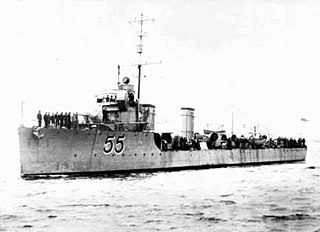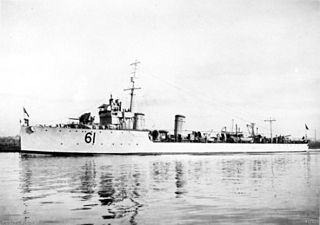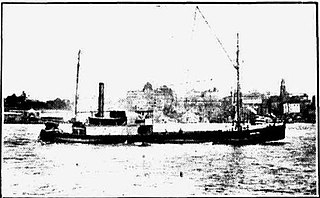Related Research Articles

Darling Harbour is a harbour adjacent to the city centre of Sydney, New South Wales, Australia that is made up of a large recreational and pedestrian precinct that is situated on western outskirts of the Sydney central business district.

Botany is a suburb in south-eastern Sydney, in the state of New South Wales, Australia. Botany is located 11 kilometres south of the Sydney central business district and is part of the Bayside Council.

HMAS Adelaide was the lead ship of the Adelaide class of guided missile frigates built for the Royal Australian Navy (RAN), based on the United States Navy's Oliver Hazard Perry-class frigates. She was built in the United States and commissioned into the RAN in 1980.

HMAS Parramatta, named after the Parramatta River, was a River-class torpedo-boat destroyer of the Royal Australian Navy (RAN). Ordered in 1909 for the Commonwealth Naval Forces, Parramatta was the first ship launched for the RAN. Temporarily commissioned into the Royal Navy for the delivery voyage to Australia, the destroyer came under Australian naval control in 1910, and was recommissioned into the RAN on 1 March 1911, shortly before the latter's formal creation.

HMAS Swan was a River-class torpedo-boat destroyer of the Royal Australian Navy (RAN). One of six built for the RAN, Swan was built at Cockatoo Island Dockyard, and entered service in 1916. The early part of the ship's career was spent on blockade duty in the Far East, before she was transferred to the Mediterranean for anti-submarine duty. Apart from performing shore bombardment during the Second Battle of Durazzo, Swan's wartime career was uneventful. The destroyer was placed in reserve in 1920, but was reactivated between 1925 and 1927 and assigned to Tasmania. Swan was decommissioned in 1928, stripped of parts, and sold for use as prisoner accommodation on the Hawkesbury River. After changing hands several times, the hull sank during gale conditions in 1933.

Rodd Point is a suburb in the Inner West of Sydney, in the state of New South Wales, Australia. It is 9 kilometres west of the Sydney central business district in the local government area of the City of Canada Bay.

Narwee is a suburb in southern Sydney, in the state of New South Wales, Australia. Narwee is located 18 kilometres south of the Sydney central business district and is part of the St George area. Narwee is in local government areas of City of Canterbury-Bankstown and Georges River Council. The postcode is 2209, which it shares with neighbouring Beverly Hills.

Shark Island is an island located with in Sydney Harbour, in New South Wales, Australia. The island is 1.5 hectares in area, measuring some 250 metres by 100 metres, and lies off the Sydney suburbs of Point Piper, Rose Bay and Vaucluse, in the eastern section of the harbour between the Harbour Bridge and the harbour entrance. The island was known by the local Aboriginal people as Boambilly, and the current name comes from its shape, which is claimed to resemble a shark.

The Berowra Creek, a watercourse that is part of the Hawkesbury-Nepean catchment, is located to the north of the Sydney central business district in the Hornsby Shire of New South Wales, Australia.

HMAS Torrens, named for the River Torrens, was a River-class torpedo-boat destroyer of the Royal Australian Navy (RAN). The destroyer was built at Cockatoo Island Dockyard and entered service with the RAN in 1916. The destroyer was first deployed to East Asia, then the Mediterranean, where she remained for the rest of World War I. After returning to Australia, the destroyer was decommissioned, but saw use in several ports for reservist training before the decision to sell her for scrap was made. After being stripped, the destroyer was towed outside Sydney Heads, used for gunnery practice, and scuttled.

Bradleys Head is a headland protruding from the north shore of Sydney Harbour, within the metropolitan area of Sydney, New South Wales, Australia. It is named after the First Fleet naval officer William Bradley. The original Aboriginal inhabitants belonged to the Borogegal clan of the Eora nation, and was known as Borogegy, Booraghee, Booragy or Burrogy. Also on the headland is an active lighthouse, Bradleys Head Light, constructed in 1905.

The SS Cawarra was a paddle-steamer that sank on 12 July 1866 in Newcastle harbour, New South Wales, Australia sending sixty people to their deaths. The sinking was one of the worst maritime disasters in Australian history.

TSS Maianbar was a coastal steamship of the North Coast Steam Navigation Company. She was built in Scotland in 1910 and ran aground in Newcastle, New South Wales in 1940.

The State Dockyard was a ship building and maintenance facility operated by the Government of New South Wales in Carrington, Newcastle, New South Wales, Australia between 1942 and 1987.

Elizabeth Macquarie was the second wife of Lachlan Macquarie, who served as Governor of New South Wales from 1810 to 1821. She played a significant role in the establishment of the colony and is recognised in the naming of many Australian landmarks including Mrs Macquarie's Chair and Elizabeth Street, Hobart. Governor Macquarie named the town of Campbelltown, New South Wales after his wife's maiden name and a statue of her now stands in Mawson Park, Campbelltown.
Argument was an Australian sloop of some 8 tons, built in Sydney and registered on 8 October 1800.
Active was a wooden ketch that was wrecked on 19 January 1898 on the Oyster Bank at the entrance of Newcastle Harbour, New South Wales, Australia, near the previously wrecked schooner Colonist while carrying a cargo of ironbark to Morpeth, New South Wales, under the command of Captain P. Williams. There were no casualties but the ship was lost. The wreck has not been located, but the approximate co-ordinates of the shipwreck are 32.92°S 151.79°E.

The Alhambra was an iron steamer screw built in 1853 by Samuda Brothers at Cubitt Town, London. It was wrecked in a collision off Newcastle, near Nobbys Head, New South Wales, on 30 June 1888.

The Queen Bee was a wooden carvel Twin-screw steamer built in 1907 at Davistown, New South Wales, that was wrecked when she sprang a leak whilst carrying coal other general cargo between Sydney and Newcastle, New South Wales. She was lost off Barrenjoey Head, Broken Bay, New South Wales on 2 September 1922.

Kanimbla was a "K-class" ferry on Sydney Harbour. Launched in 1910, the timber-hulled steamer was built for Sydney Ferries Limited during the boom in cross-harbour ferry travel prior to the opening of the Sydney Harbour Bridge. Kanimbla was renamed "Kurra-Ba" in 1935. She was laid up in the 1940s and broken up in the 1950s.
References
- ↑ Australian Shipwrecks - vol 1 1622–1850, Charles Bateson, AH and AW Reed, Sydney, 1972, ISBN 0-589-07112-2 p45